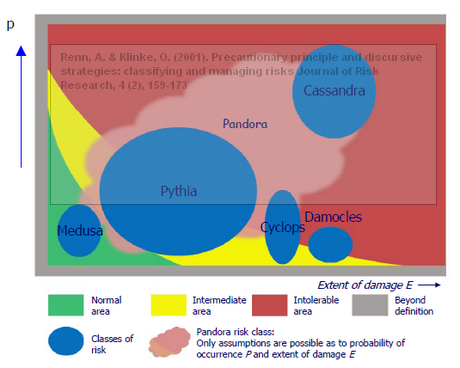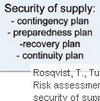 Risk. The probability of an event occurring and the consequences of the event occurring. That is how most of us would classify and compare risks in a scientific manner. Does it have to be like that or is there a different, or perhaps even a better way? Maybe there is. Ten years ago, Andreas Klinke and Ortwin Renn set out to do just that, in Precautionary principle and discursive strategies: classifying and managing risks. Here they developed an integral risk concept based on eight criteria for classifying and managing risk. A novel approach, but what happened to it?
Risk. The probability of an event occurring and the consequences of the event occurring. That is how most of us would classify and compare risks in a scientific manner. Does it have to be like that or is there a different, or perhaps even a better way? Maybe there is. Ten years ago, Andreas Klinke and Ortwin Renn set out to do just that, in Precautionary principle and discursive strategies: classifying and managing risks. Here they developed an integral risk concept based on eight criteria for classifying and managing risk. A novel approach, but what happened to it?
Risk society
Today’s posts follows up on yesterday’s topic of the risk society, where Jan Hovden of the Norwegian University of Science and Technology, NTNU, developed a framework for risk and vulnerability that incorporated both a micro and a macro perspective. In one of his papers on the subject, available for download in the previous post, Hovden refers extensively to the risk classification scheme developed by Klinke and Renn. It is an interesting framework indeed and it turns traditional risk thinking on its head…slightly.
Criteria-based risk evaluation
The accepted way of risk evaluation involves assessing the the extent of impacts and the probability of occurrence. While damages may have concrete methods for validation, the probability estimate is often more uncertain; sometimes no statistical linkage or frequence (yet) exists and sometimes the probability assessment itself can be wrought with error. Consequently, Renn and Klinke devise eight criteria for classifying and then managing risks:
- Probability
- statistical frequency,
reliable estimates
- statistical frequency,
- Potential for harm
- known extent of damage
- Incertitude
- uncertainty, fuzziness or ignorance
- Ubiquity
- geographical dispersion of potential damages
- Persistency
- temporal extension, e.g. long-lasting effects
- Delayed Effects
- latent and unnoticeable effects that manifest later
- Reversibility
- potential for restoration to the state before the damage occured
- Potential for Social Mobilization
- psychological(over-)reaction to wrongly (or rightly) perceived risk
Combining these dimensions of the risk concept Klinke and Renn develop six main types of risks determining the choice of risk management strategy.
Mythological risk classification
These risk types, named after metaphors from Greek mythology, are comprised by the following characterization of risks:
- Damocles
- high catastrophic potential,
probabilities (widely) known
- high catastrophic potential,
- Cyclops
- no reliable estimate for probabilities,
high catastrophic potential
- no reliable estimate for probabilities,
- Pythia
- causal connection confirmed,
damage potential and probabilities unknown
- causal connection confirmed,
- Pandora
- causal connection unclear,
high persistency and ubiquity
- causal connection unclear,
- Cassandra
- intolerable risk of high probability and great damage,
but long delay between causal stimulus and negative effect
- intolerable risk of high probability and great damage,
- Medusa
- large potential for social mobilization
without clear scientific evidence for serious harm
- large potential for social mobilization
In my opinion, this perspective looks at risk not so much from a purely objective point of view, but includes the societal and personal sphere and takes risk much closer to the point of decision-making than the more traditional approach.
Normal, intermediate, intolerable risk
The different risk types can be placed in a traditional probability-consequence diagram as such:

At the back of this diagram are three areas of concern, normal, intermediate and intolerable. The intermediate and intolerable are the areas where risks go beyond ordinary dimensions. The usual risk management strategies would seek to move risks from the intolerable to the intermediate (and normal) and from the intermediate to the normal, thus transforming risks from the unacceptable to the acceptable.
Risk management: risk based, precautionary and discursive
Renn and Klinke advocate that these 6 types of risk should be handled by three types of risk management strategies: risk-based, precautionary and discursive.
Damocles and Cyclops: risk-based. These risks can be handled and managed adequately by strategies and regulations based on the two main risk characteristics: extent of damage and probability of occurrence. That is particularly so with the Damocles class, since here the probabilities are well known. With the Cyclops class, precautionary measures are more appropriate, since here the probabilities are not well defined.
Pythia and Pandora: precautionary. These risks are characterized by a high degree of uncertainty as to probability of occurrence and extent of damage, hence a “just in case” approach may be justified.
Cassandra and Medusa: discursive. These risks are characterized by either a delay effect, where the dangers initially may not be known or perhaps are even ignored, or risks where presumably harmless effects are perceived as threats by certain portions of the public or pressure groups. These risks require knowledge-building strategies to raise awareness and confidence.
Not scientific?
It should be mentioned that the risk evaluation, risk classification and risk management strategies were developed by the ‘German Advisory Council on Global Change (WBGU)’ in their 1998 annual report about global environmental risks. Both Renn and Klinke worked with this group. So, is this a usable framework? I think it is. While it may defy the common scientific definitions of risk, I nevertheless think it is valuable contribution to the risk management of technological and environmental risks. It is certainly a perspective worth pondering.
Reference
Renn, A. Klinke, O. (2001). Precautionary principle and discursive strategies: classifying and managing risks Journal of Risk Research, 4 (2), 159-173 DOI: 10.1080/136698701750128105
Author links
- mun.ca: Andreas Klinke
- uni-stuttgart.de: Ortwin Renn
Related
- husdal.com: Six ways of dealing with risk












